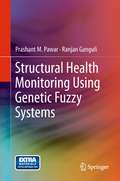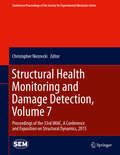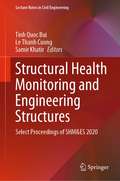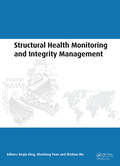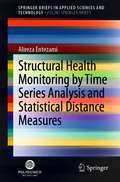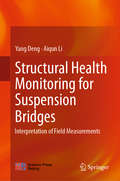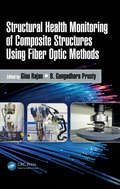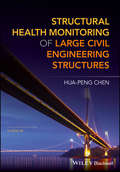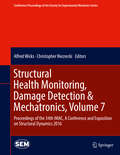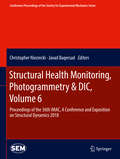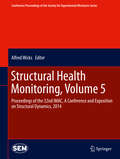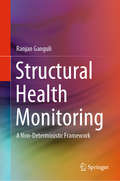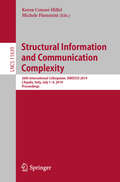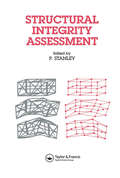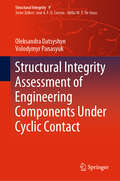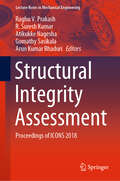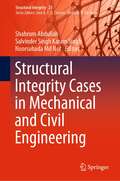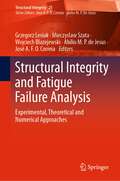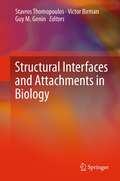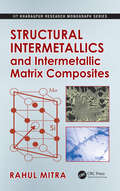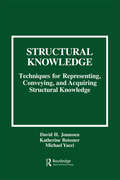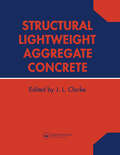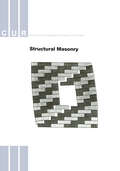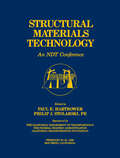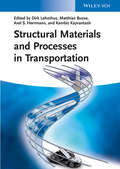- Table View
- List View
Structural Health Monitoring Using Genetic Fuzzy Systems
by Prashant M. Pawar Ranjan GanguliStructural health monitoring (SHM) has emerged as a prominent research area in recent years owing to increasing concerns about structural safety, and the need to monitor and extend the lives of existing structures. Structural Health Monitoring Using Genetic Fuzzy Systems elaborates the process of intelligent SHM development and implementation using the evolutionary system. The use of a genetic algorithm automates the development of the fuzzy system, and makes the method easy to use for problems involving a large number of measurements, damage locations and sizes; such problems being typical of SHM. The ideas behind fuzzy logic, genetic algorithms and genetic fuzzy systems are also explained. The functionality of the genetic fuzzy system architecture is elucidated within a case-study framework, covering: * SHM of beams; * SHM of composite tubes; and * SHM of helicopter rotor blades. Structural Health Monitoring Using Genetic Fuzzy Systems will be useful for aerospace, civil and mechanical engineers working with structures and structured components. It will also be useful for computer scientists and applied mathematicians interested in the application of genetic fuzzy systems to engineering problems.
Structural Health Monitoring and Damage Detection, Volume 7
by Christopher NiezreckiStructural Health Monitoring & Damage Detection, Volume 7: Proceedings of the 33rd IMAC, A Conference and Exposition on Structural Dynamics, 2015, the seventh volume of ten from the Conference brings together contributions to this important area of research and engineering. The collection presents early findings and case studies on fundamental and applied aspects of Structural Dynamics, including papers on: Structural Health Monitoring Damage Detection Energy Harvesting
Structural Health Monitoring and Engineering Structures: Select Proceedings of SHM&ES 2020 (Lecture Notes in Civil Engineering #148)
by Tinh Quoc Bui Le Thanh Cuong Samir KhatirThe book presents the select proceedings of International Conference on Structural Health Monitoring and Engineering Structures (SHM&ES) 2020. It brings together different applied and technological aspects of structural health monitoring. The main topics covered in this book include damage assessment, structural health monitoring, engineering fracture mechanics, Inverse problem using optimization techniques, machine learning, deep learning, Artificial intelligent and non-destructive evaluation. It will be a reference for professionals and students in the areas of civil engineering, applied natural sciences and engineering management.
Structural Health Monitoring and Integrity Management: Proceedings of the 2nd International Conference of Structural Health Monitoring and Integrity Management (ICSHMIM 2014), Nanjing, China, 24-26 September 2014
by Keqin Ding Shenfang Yuan Zhishen WuStructural Health Monitoring and Integrity Management is a collection of the papers presented at the 2nd International Conference of Structural Health Monitoring and Integrity Management (ICSHMIM2014, Nanjing, China, 24-26 September 2014), and addresses the most recent developments in the field of Structural Health Monitoring (SHM) and integrity ma
Structural Health Monitoring by Time Series Analysis and Statistical Distance Measures (SpringerBriefs in Applied Sciences and Technology)
by Alireza EntezamiThis book conducts effective research on data-driven Structural Health Monitoring (SHM), and accordingly presents many novel feature extraction methods by time series analysis and signal processing, to extract reliable damage sensitive features from vibration responses. In this regard, some limitations of time series modeling are dealt with. For decision-making, innovative distance-based novelty detection techniques are presented to detect, locate, and quantify different damage scenarios. The performance of the presented methods is demonstrated via laboratory and full-scale structures along with several comparative studies. The main target audience of the book includes scholars, graduate students working on SHM via statistical pattern recognition in terms of feature extraction and classification for damage diagnosis under environmental and operational variations; it would also be beneficial for practicing engineers whose work involves these topics.
Structural Health Monitoring for Suspension Bridges: Interpretation of Field Measurements
by Yang Deng Aiqun LiThis book presents extensive information on structural health monitoring for suspension bridges. During the past two decades, there have been significant advances in the sensing technologies employed in long-span bridge health monitoring. However, interpretation of the massive monitoring data is still lagging behind. This book establishes a series of measurement interpretation frameworks that focus on bridge site environmental conditions, and global and local responses of suspension bridges. Using the proposed frameworks, it subsequently offers new insights into the structural behaviors of long-span suspension bridges. As a valuable resource for researchers, scientists and engineers in the field of bridge structural health monitoring, it provides essential information, methods, and practical algorithms that can facilitate in-service bridge performance assessments.
Structural Health Monitoring of Composite Structures Using Fiber Optic Methods (Devices, Circuits, and Systems)
by Ginu Rajan and B. Gangadhara PrustyThis highly comprehensive, introductory book explains the basics of structural health monitoring aspects of composite structures. This book serve as an all-in-one reference book in which the reader can receive a basic understanding of composite materials, manufacturing methods, the latest types of optical fiber sensors used for structural health monitoring of composite structures, and demonstrated applications of the use of fiber sensors in a variety of composite material structures. The content draws upon the authors’ and distinguished contributors’ extensive research/teaching and industrial experience to fully cover the structural health monitoring of composite materials using fiber optic sensing methods.
Structural Health Monitoring of Large Civil Engineering Structures
by Hua-Peng ChenA critical review of key developments and latest advances in Structural Health Monitoring technologies applied to civil engineering structures, covering all aspects required for practical application Structural Health Monitoring (SHM) provides the facilities for in-service monitoring of structural performance and damage assessment, and is a key element of condition based maintenance and damage prognosis. This comprehensive book brings readers up to date on the most important changes and advancements in the structural health monitoring technologies applied to civil engineering structures. It covers all aspects required for such monitoring in the field, including sensors and networks, data acquisition and processing, damage detection techniques and damage prognostics techniques. The book also includes a number of case studies showing how the techniques can be applied in the development of sustainable and resilient civil infrastructure systems. Structural Health Monitoring of Large Civil Engineering Structures offers in-depth chapter coverage of: Sensors and Sensing Technology for Structural Monitoring; Data Acquisition, Transmission, and Management; Structural Damage Identification Techniques; Modal Analysis of Civil Engineering Structures; Finite Element Model Updating; Vibration Based Damage Identification Methods; Model Based Damage Assessment Methods; Monitoring Based Reliability Analysis and Damage Prognosis; and Applications of SHM Strategies to Large Civil Structures. Presents state-of-the-art SHM technologies allowing asset managers to evaluate structural performance and make rational decisions Covers all aspects required for the practical application of SHM Includes case studies that show how the techniques can be applied in practice Structural Health Monitoring of Large Civil Engineering Structures is an ideal book for practicing civil engineers, academics and postgraduate students studying civil and structural engineering.
Structural Health Monitoring, Damage Detection & Mechatronics, Volume 7
by Alfred Wicks Christopher NiezreckiStructural Health Monitoring, Damage Detection & Mechatronics, Volume 7. Proceedings of the 34th IMAC, A Conference and Exposition on Dynamics of Multiphysical Systems: From Active Materials to Vibroacoustics, 2016, the seventh volume of ten from the Conference brings together contributions to this important area of research and engineering. The collection presents early fi ndings and case studies on fundamental and applied aspects of Structural Dynamics, including papers on: * Structural Health Monitoring * Damage Detection * Numerical Modeling * Mechatronics * System Identifi cation * Active Controls
Structural Health Monitoring, Photogrammetry & DIC, Volume 6: Proceedings Of The 36th Imac, A Conference And Exposition On Structural Dynamics 2018 (Conference Proceedings of the Society for Experimental Mechanics Series)
by Christopher Niezrecki Javad BaqersadStructural Health Monitoring Photogrammetry & DIC, Volume 6: Proceedings of the 36th IMAC, A Conference and Exposition on Structural Dynamics, 2018, the sixth volume of nine from the Conference brings together contributions to this important area of research and engineering. The collection presents early findings and case studies on fundamental and applied aspects of Structural Health Monitoring & Damage Detection, including papers on:Structural Health MonitoringDamage DetectionSystem IdentificationActive Controls
Structural Health Monitoring, Volume 5
by Alfred WicksThis fifth volume of eight from the IMAC - XXXII Conference, brings together contributions to this important area of research and engineering. The collection presents early findings and case studies on fundamental and applied aspects of Structural Dynamics, including papers on: Linear Systems Substructure Modelling Adaptive Structures Experimental Techniques Analytical Methods Damage Detection Damping of Materials & Members Modal Parameter Identification Modal Testing Methods System Identification Active Control Modal Parameter Estimation Processing Modal Data
Structural Health Monitoring: A Non-Deterministic Framework
by Ranjan GanguliThis book discusses systems of damage detection and structural health monitoring in mechanical, civil, and aerospace structures. It utilizes principles of fuzzy logic, probability theory, and signal processing to develop systems and approaches that are robust in the presence of both noise in the data and variations in properties of materials which are intrinsic to the process of mass production. This volume will be useful to graduate students, researchers, and engineers working in this area, especially those looking to understand and address model uncertainty in their algorithms.
Structural Information and Communication Complexity: 26th International Colloquium, SIROCCO 2019, L'Aquila, Italy, July 1–4, 2019, Proceedings (Lecture Notes in Computer Science #11639)
by Michele Flammini Keren Censor-HillelThis book constitutes the refereed conference proceedings of the 26th International Colloquium on Structural Information and Communication Complexity, SIROCCO 2019, held in L’Aquila, Italy, in July 2019.The 19 full papers and 9 short papers presented in this book were carefully reviewed and selected from 39 submissions. They are devoted to the study of the interplay between structural knowledge, communication, and computing in decentralized systems of multiple communicating entities.
Structural Integrity Assessment
by P. StanleyThe assessment of structural integrity is a vitally important consideration in many fields of engineering, which has an influence on the full range of professional activities from conception, design and analysis, through operation to residual life evaluation and possible life extension. In devising satisfactory procedures for this purpose there is
Structural Integrity Assessment of Engineering Components Under Cyclic Contact (Structural Integrity #9)
by Oleksandra Datsyshyn Volodymyr PanasyukThis book focuses on surface layers fracture of cyclical contacting bodies (machine parts). Calculation models and calculating procedures of stress-strain states of cyclically contacting solids with cracks, are included. Recommendations for the optimization of operating parameters of joints (contact stresses magnitude, friction/lubrication conditions, materials crack resistance etc) for elements of rolling pairs (wheel–rail systems, backup roll – working roll of rolling mills etc.) and some fretting pairs are formulated.
Structural Integrity Assessment: Proceedings of ICONS 2018 (Lecture Notes in Mechanical Engineering)
by Raghu V. Prakash R. Suresh Kumar Atikukke Nagesha Gomathy Sasikala Arun Kumar BhaduriThis volume contains selected papers from the Second Quadrennial International Conference on Structural Integrity (ICONS-2018). The papers cover important topics related to structural integrity of critical installations, such as power plants, aircrafts, spacecrafts, defense and civilian components. The focus is on assuring safety of operations with high levels of reliability and structural integrity. This volume will be of interest to plant operators working with safety critical equipment, engineering solution providers, software professionals working on engineering analysis, as well as academics working in the area.
Structural Integrity Cases in Mechanical and Civil Engineering (Structural Integrity #23)
by Shahrum Abdullah Salvinder Singh Karam Singh Noorsuhada Md NorThis book covers most of the damage mechanism in the scope of mechanical engineering and civil engineering. The failure pattern of various materials and structures is mainly discussed. The sub-topics covers fatigue damage, fatigue crack initiation and propagation, life prediction techniques, computational fracture mechanics, dynamic fracture, damage mechanics and assessment, non-destructive test (NDT), concrete failure assessment, failure on soil structures, structural durability and reliability, structural health monitoring, construction damage recovery, and any relevant topics related to failure analysis.
Structural Integrity and Fatigue Failure Analysis: Experimental, Theoretical and Numerical Approaches (Structural Integrity #25)
by Grzegorz Lesiuk Mieczyslaw Szata Wojciech Blazejewski Abílio M. P. de Jesus José A. F. O. CorreiaThis book contains full papers presented at the First Virtual Conference on Mechanical Fatigue (VCMF 2020), which was organised by the University of Porto (FEUP, Portugal), the Wroclaw University of Science and Technology (Poland), University of Electronic Science and Technology of China (China), Siberian Federal University (Russia), and the ESIS/TC12 Technical Committee (European Structural Integrity Society–ESIS), between 9 and 11 of September 2020. This conference was intended to be a forum of discussion of new research concepts, equipment, technology, materials and structures and other scientific advances within the field of mechanical fatigue and fracture. The first edition of the VCMF 2020 event has reached more than 60 participants from more than 20 nationalities demonstrating the vitality of this new event.
Structural Interfaces and Attachments in Biology
by Guy M. Genin Stavros Thomopoulos Victor BirmanAttachment of dissimilar materials in engineering and surgical practice is a perennial challenge. Bimaterial attachment sites are common locations for injury, repeated injury, and mechanical failure. Nature presents several highly effective solutions to the challenge of bimaterial attachment that differ from those found in engineering practice. Structural Interfaces and Attachments in Biology describes the attachment of dissimilar materials from multiple perspectives. The text will simultaneously elucidate natural bimaterial attachments and outline engineering principles underlying successful attachments to the communities of tissue engineers and surgeons. Included an in-depth analysis of the biology of attachments in the body and mechanisms by which robust attachments are formed, a review of current concepts of attaching dissimilar materials in surgical practice and a discussion of bioengineering approaches that are currently being developed.
Structural Intermetallics and Intermetallic Matrix Composites (IIT Kharagpur Research Monograph Series)
by Rahul MitraFills a Prominent Gap in a Significant Area of IntermetallicsPresenting a comprehensive overview of structural intermetallics (the most important class of intermetallics), Structural Intermetallics and Intermetallic Matrix Composites is a reference written with the beginning student as well as the practicing professional in mind. Utilizing the auth
Structural Knowledge: Techniques for Representing, Conveying, and Acquiring Structural Knowledge
by David H. Jonassen Katherine Beissner Michael YacciThis book introduces the concept of a hypothetical type of knowledge construction -- referred to as structural knowledge -- that goes beyond traditional forms of information recall to provide the bases for knowledge application. Assuming that the validity of the concept is accepted, the volume functions as a handbook for supporting the assessment and use of structural knowledge in learning and instructional settings. It's descriptions are direct and short, and its structure is consistent. Almost all of the chapters describe a technique for representing and assessing structural knowledge acquisition, conveying knowledge structures through direct instruction, or providing learners with strategies that they may use to acquire structural knowledge. These chapters include the following sections in the same sequence: * description of the technique and its theoretical or conceptual rationale * examples and applications * procedures for development and use * effectiveness -- learner interactions and differences, and advantages and disadvantages * references to the literature. The chapters are structured to facilitate access to information as well as to illuminate comparisons and contrasts among the techniques.
Structural Lightweight Aggregate Concrete
by John L. ClarkeLightweight aggregate concrete is undergoing something of a renaissance. Although this material has been available for many years, only now is it being used more widely. This book provides a comprehensive review of this growing field from an international perspective.
Structural Masonry: An Experimental/ Numerical Basis for Practical Design Rules (CUR Report 171)
by CUR Centre for Civil Engineering Research and CodesThis text provides a basis for a standardized approach to structural masonry, using an integration of experimental and computational techniques. Accurate displacement-controlled materials experiments have produced an extensive database of strength, stiffness and softening properties for tension, compression and shear, and this data has been transferred into numerical models for simulating the deformational behaviour of masonry structures. The models have been implemented into finite and distinct element codes and have subsequently been verified against shear wall experiments and analytical solutions for masonry parts.
Structural Materials Technology: An NDT Conference (1996)
by Paul E. Hartbower and Philip J. Stolarski, PeThis book is a collection of papers presented in the NDT Conference held on February 20-23, 1996 at San Diego, California. The conference provided an opportunity to share experience and provide additional input to the Federal Highway Administration.
Structural Materials and Processes in Transportation
by Matthias Busse Dirk Lehmhus Axel Herrmann Kambiz KayvantashLightness, efficiency, durability and economic as well as ecological viability are key attributes required from materials today. In the transport industry, the performance needs are felt exceptionally strongly. This handbook and ready reference covers the use of structural materials throughout this industry, particularly for the road, air and rail sectors. A strong focus is placed on the latest developments in materials engineering. The authors present new insights and trends, providing firsthand information from the perspective of universities, Fraunhofer and independent research institutes, aerospace and automotive companies and suppliers.Arranged into parts to aid the readers in finding the information relevant to their needs:* Metals* Polymers* Composites* Cellular Materials* Modeling and Simulation* Higher Level Trends
